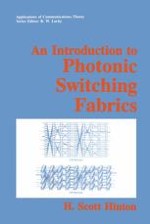1993 | Buch
An Introduction to Photonic Switching Fabrics
verfasst von: H. Scott Hinton, J. R. Erickson, T. J. Cloonan, F. A. P. Tooley, F. B. McCormick, A. L. Lentine
Verlag: Springer US
Buchreihe : Applications of Communications Theory
Enthalten in: Professional Book Archive
